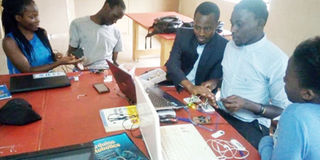Robotics to create a shift towards adoption of sciences

Students who participated in the robotics training during one of the sessions. The training enhanced the students’ innovation capacity as well as teamwork skills. Photo by Dorcus Murungi
What you need to know:
- There has always been concern that our university students especially those in science-based courses cannot create anything.
- But a recent training in robotics has revealed that students, once tickled to create, are capable of inventing great things.
Last year Zillah Nangobi, a second year Computer Engineering student at Makerere University, was trained in robotics under the Silver Bullet student development programme. Though it was a short training, Nangobi says it has helped her simplify all the complex scientific theories she has been learning in class without necessarily getting sufficient practice.
Currently, she finds her learning fun and interesting, which she says has improved her innovation capacity. “I already have a project I am working on which is called a marking mixer, I would not have been able to come up with this idea had it not been the robotics training I got,” she says.
Like Nangobi, more than 30 students from the universities of Makerere and Kyambogo have been trained in robotics under the Silver Bullet Student Development programme.
Maryanne Karamagi, the executive director Silver Bullet, says the main aim of the training was to enhance the engineering capacity and accelerate social economic growth among university students.
She explains that the training in robotics is set out to strengthen the Science, Technology, Engineering and Innovation workforce by up skilling through supplemental activities, school outreach and university after-school training programmes.
“This programme provides students with practical and applicable skills allowing them to apply the theories they have been taught in school in a fun and interesting way. It supplements the national curriculum while advocating for a revision to existing curricula to allow inclusion of subjects like robotics which motivate young people to be excited about engineering and science careers,” she explains.
Important aspect
Henry Masiriwa, a lecturer at the department of Electro Association Fundi bot, says Robotics is defined as a branch of engineering that involves the conception, design, manufacture, and operation of robots. He says this programme overlaps with multiple academic disciplines including mechanical engineering, electrical engineering, computer science, interaction design and psychology.
Masiriwa says robotics is important in a student’s learning because it teaches students 21st Century skills including coding, engineering and the scientific method in a fun and engaging way.
He adds that robotics can be a launching pad for students to realise their passions. “It is amazing to watch students’ passions grow in subjects that they never knew they would love. Some of my students have cultivated an interest in coding, and have even gone as far as taking part in fixing household appliances because they have a new-found interest in mechanics. You can watch these students build their own learning pathways because robotics offers them an open platform where they can decide where to go with their experimentations, especially those in lower education,” he says.
Karamagi observes that robotics can also inspire community involvements. She explains that with robotics, there are numerous benefits of student community involvement, including increased attendance, higher grades, a sense of greater security, fewer behavioral problems and an increase in positive attitudes about school and homework.
“Teaching robotics in the classroom can create a sense of community within the classroom that expands to the community in which you live. Through opportunities such as these, students begin seeing robotics as more than a project for a grade but rather a tool that can inspire others,” she observes.
Life skills
Apart from robotics equipping students with practical skills, Karamagi says it teaches essential teamwork skills as well.
“When students work in groups on a project with a robot they quickly see that technical skills, such as coding, are very important. However, their robot will not move if they do not know how to collaborate with others and communicate their ideas so this teaches them to listen and relate with others, which is an important life skill,” she says. According to Prof Kosah Ayorkor, the head of the Computer Science Department Asheshi University, Ghana, if robotics is well implemented in several institutions of learning, it will increase students’ interest in science subjects by making it fun and applicable.
She adds that it will also impact applicable skills in university students to ready them for industry applications.
“In a rapidly transforming world, subjects such as robotics need to be introduced into the curriculum to allow young people the opportunity to be part of defining the future. The advancements in technology are leading us towards things such as artificial intelligence and it is important for us to adjust to the changing trends,” she said. Prof Ayorkor added that robotics training opens the minds of people and encourages them to think of creative solutions to problems which will shape the next generation of African entrepreneurs.
According to the National Planning Authority, 700,000 people join the job market every year but only 12 per cent can be absorbed in the current job market, leaving 88 per cent unemployed. Prof Ayorkor believes that this can be solved if students are able to embrace science and think creatively.
Surveillance system
We have a robotics team – which is a side activity away from the academics at IUEA. Here, we are taught about robotics and currently, we are working on a project - building a car surveillance system.
This is a smart home surveillance system that will have multiple functions when we get done with it. It will be able to; pick up sound, take videos, see what is at a distance, will be able to detect obstacles and able to control the lighting system in a home using a timer. It will also be able to pick feedback, move for example in a compound or house and do all those functions.
As far as progress, we have already built the body where the sockets will be housed, we have done the coding, - I specifically did the parking coding that detects obstacles. We have built a control module/app that is connected to a mobile app, so it can connect everywhere, plus the camera module.
The car surveillance concept was my suggestion, because in my free time, I build modules. One of our short term goals is to enter inter-university competitions, although we have a long way to go. We are still working on that body to adopt to functions and implement some parts but we want to have a working prototype by the end of this semester.
So far, all the parts we have made are on the table as standalone, but we want to be able to put them together. However, the surveillance car works as a proof of concept that we can build our own robots without studying a specific course.
Andrew Bakashaba, International University of East Africa




